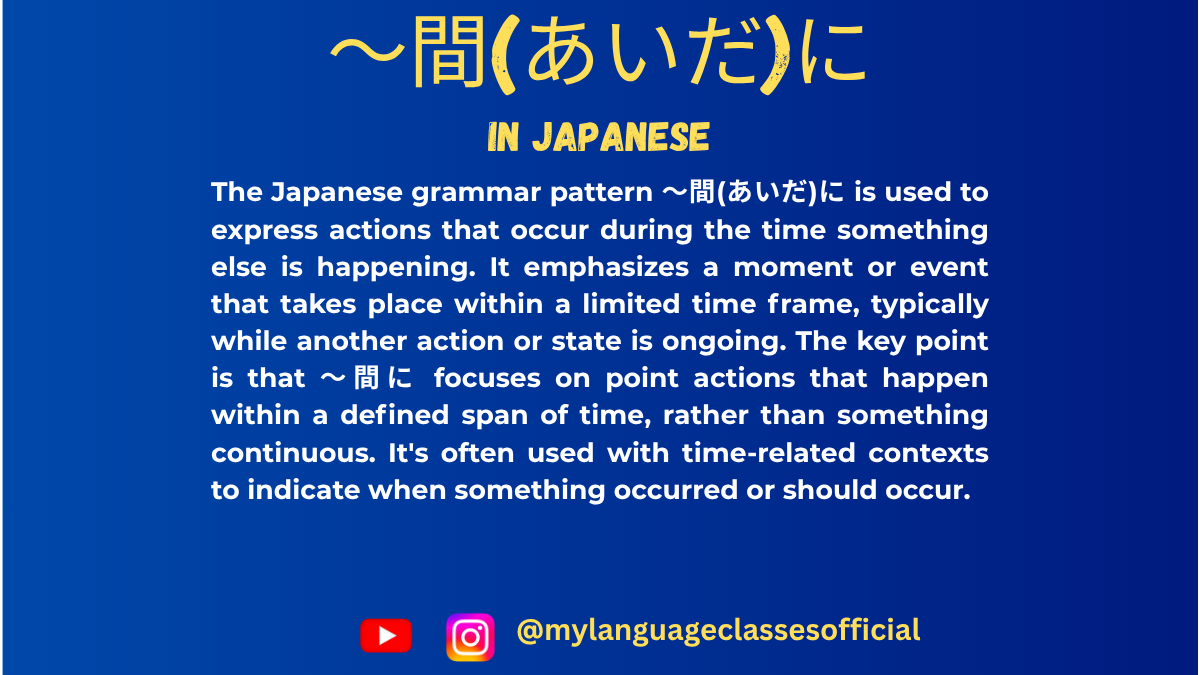Your cart is currently empty!
Tag: my language classes
-
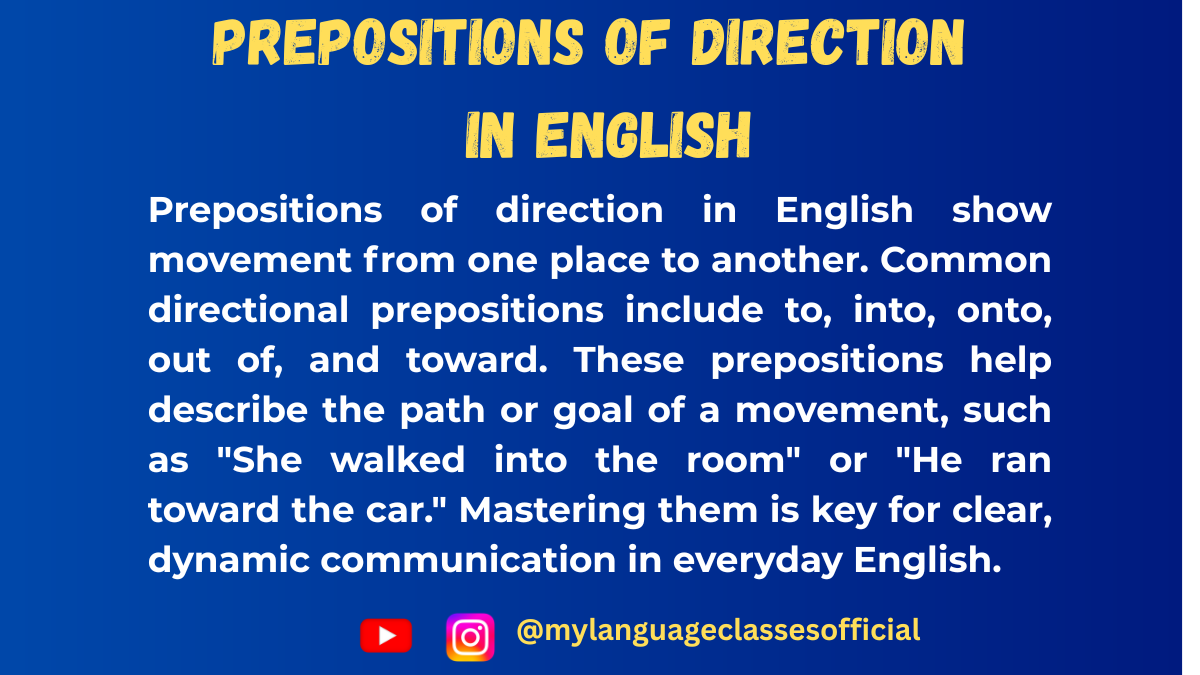
Prepositions of Direction in English
Prepositions of direction indicate movement from one place to another. They are essential in describing how something moves or changes position concerning another object.
List of Prepositions of Direction and Their Usage
Preposition Meaning Example Sentence 1 Example Sentence 2 To Movement towards a destination She went to the park. He sent a letter to his friend. Into Movement from outside to inside She walked into the room. The cat jumped into the box. Onto Movement towards a surface The child climbed onto the table. He jumped onto the bed. Out of Movement from inside to outside She ran out of the house. He took his phone out of his pocket. Towards Movement in the direction of something She moved towards the door. He walked towards me with a smile. Away from Movement in the opposite direction She walked away from the fire. The dog ran away from the stranger. Up Movement from a lower position to a higher one He climbed up the hill. The plane soared up into the sky. Down Movement from a higher position to a lower one The ball rolled down the hill. She walked down the stairs. Across Movement from one side to another He swam across the river. The children ran across the street. Over Movement above something The bird flew over the lake. He jumped over the fence. Under Movement beneath something The dog crawled under the table. The ball rolled under the chair. Along Movement following a path He walked along the beach. The car drove along the highway. Past Movement beyond a certain point They walked past the school. He drove past the mall. Through Movement within a space from one end to another She ran through the tunnel. The wind blew through the trees. Around Movement in a circular direction He walked around the park. The car drove around the roundabout.
More Example Sentences
- The boy ran to his mother as soon as he saw her.
- She poured the coffee into the cup carefully.
- He jumped onto the boat from the dock.
- The cat ran out of the house when the door was open.
- The athlete sprinted towards the finish line.
- They moved away from the dangerous area.
- The monkey climbed up the tree quickly.
- She walked down the street, enjoying the fresh air.
- He drove across the city to meet his friend.
- The plane flew over the mountains.
Fill in the Blanks
- She jumped ___ the swimming pool.
- He walked ___ the tunnel to reach the other side.
- The dog ran ___ the street to chase the cat.
- The helicopter flew ___ the buildings.
- He climbed ___ the ladder to fix the roof.
- The train passed ___ the bridge.
- The girl moved ___ the stage to receive her award.
- The kids walked ___ the road to reach school.
- The car drove ___ the highway without stopping.
- He ran ___ the hill with great speed.
Answers:
- into
- through
- across
- over
- up
- over
- towards
- across
- along
- down
Things to Keep in Mind
- Prepositions of direction always describe movement from one place to another.
- Some prepositions like to and towards may seem similar but have different uses (e.g., “to” specifies the destination, while “towards” indicates movement in a direction without necessarily reaching the destination).
- Prepositions such as into and onto describe entering or moving onto a surface, while in and on describe static positions.
- Over and under describe movement above and below something, respectively.
- Across and through both describe movement, but “across” is typically for flat surfaces, while “through” indicates movement within an enclosed space.
Conclusion
Prepositions of direction are essential for clear communication when describing movement and changes in position. Understanding their proper usage will enhance both written and spoken English. By practicing these prepositions in different contexts, you can develop a natural sense of their application and improve your fluency. Keep practicing with more sentences and exercises to master this important grammar topic!
If you enjoyed this lesson, be sure to check out more posts like this on my blog at My Language Classes. Don’t forget to subscribe my YouTube channel and follow me on Instagram for the latest language learning tips and lessons. Leave a comment below to share your thoughts, or ask any questions you have about nouns.
Happy learning! 😊
-
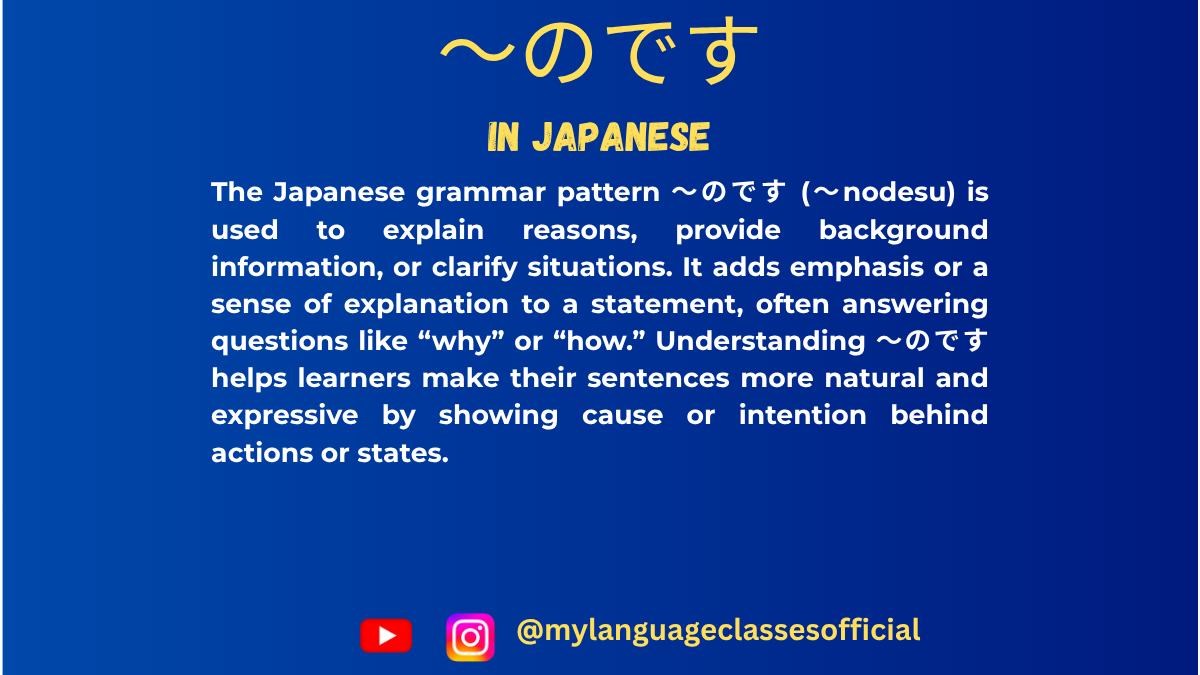
Understanding 〜のですin Japanese | My Language Classes
Understanding 〜のです in Japanese
The 〜のです (or its casual form 〜んです) is a grammatical structure in Japanese used to give explanations, seek clarifications, or express emotions. It adds a sense of reasoning to a statement and is often used in both spoken and written Japanese.
Formation of 〜のです
1. Formation with Verbs
- Affirmative (Present/Future):
- Dictionary form + のです / んです
- Example: 食べるのです (taberu no desu)
- Negative (Present/Future):
- ない-form + のです / んです
- Example: 食べないのです (tabenai no desu)
- Past Affirmative:
- た-form + のです / んです
- Example: 食べたのです (tabeta no desu)
- Past Negative:
- なかった-form + のです / んです
- Example: 食べなかったのです (tabenakatta no desu)
2. Formation with Nouns
- Affirmative:
- Noun + なのです / なんです (casual)
- Example: 学生なのです (gakusei nano desu)
- Negative:
- Noun + ではないのです / じゃないんです (casual)
- Example: 学生ではないのです (gakusei dewa nai no desu)
3. Formation with Adjectives
- i-Adjectives:
- そのまま + のです / んです
- Example: うれしいのです (ureshii no desu)
- Negative: うれしくないのです (ureshikunai no desu)
- na-Adjectives:
- な + のです / んです
- Example: 静かなのです (shizuka nano desu)
- Negative: 静かではないのです (shizuka dewa nai no desu)
Usage of 〜のです
The 〜のです form is used in various situations. Below are the key contexts in which it is used:
1. Providing an Explanation
This form is often used to explain reasons behind actions or situations.
- Example: どうして遅れたのですか? (Why were you late?)
- Example: 雨が降っていたのです。(It was raining.)
2. Seeking Clarification or Confirmation
When you are trying to confirm or seek clarification about something.
- Example: その本はあなたのものなのですか? (Is that book yours?)
3. Expressing a Justification
To justify an action or event.
- Example: 宿題が多かったのです。(I had a lot of homework.)
4. Making a Statement More Emphatic
Using のです makes the statement more formal or assertive.
- Example: 私が行くのです。(I will go.)
5. Stating a Fact with Emphasis
- Example: これはとても大切なのです。(This is very important.)
Other Usage of 〜のです
Situations where 〜のです is used
- Giving explanations or reasons
- Asking for explanations or clarifications
- Expressing emotions such as surprise or concern
- Emphasizing a statement
- Giving background information
- Making an indirect request
- Softening a statement
- Seeking confirmation
- Expressing curiosity
- Describing an unusual situation
List of Verbs with their 〜のです Form
Verb (Dictionary Form) 〜のです Form Example Sentence 1 Romaji Meaning Example Sentence 2 Romaji Meaning 食べる (taberu) 食べるのです これは毎日食べるのです。 Kore wa mainichi taberu no desu. I eat this every day. 彼は魚を食べるのですか? Kare wa sakana o taberu no desu ka? Does he eat fish? 行く (iku) 行くのです 学校へ行くのです。 Gakkou e iku no desu. I am going to school. どこへ行くのですか? Doko e iku no desu ka? Where are you going? 来る (kuru) 来るのです 明日、彼が来るのです。 Ashita, kare ga kuru no desu. He is coming tomorrow. どうして来るのですか? Doushite kuru no desu ka? Why is he coming? 見る (miru) 見るのです 彼はテレビを見るのです。 Kare wa terebi o miru no desu. He watches TV. 何を見ているのですか? Nani o mite iru no desu ka? What are you watching? 書く (kaku) 書くのです 彼女は日記を書くのです。 Kanojo wa nikki o kaku no desu. She writes a diary. 何を書いているのですか? Nani o kaite iru no desu ka? What are you writing? 話す (hanasu) 話すのです 先生は日本語を話すのです。 Sensei wa nihongo o hanasu no desu. The teacher speaks Japanese. 彼と何を話していたのですか? Kare to nani o hanashite ita no desu ka? What were you talking about with him? 買う (kau) 買うのです 私は新しい車を買うのです。 Watashi wa atarashii kuruma o kau no desu. I will buy a new car. 何を買ったのですか? Nani o katta no desu ka? What did you buy? 泳ぐ (oyogu) 泳ぐのです 彼は毎朝泳ぐのです。 Kare wa maiasa oyogu no desu. He swims every morning. どこで泳ぐのですか? Doko de oyogu no desu ka? Where do you swim? 勉強する (benkyou suru) 勉強するのです 私は毎日日本語を勉強するのです。 Watashi wa mainichi nihongo o benkyou suru no desu. I study Japanese every day. 何を勉強しているのですか? Nani o benkyou shite iru no desu ka? What are you studying? 働く (hataraku) 働くのです 彼は銀行で働くのです。 Kare wa ginkou de hataraku no desu. He works at a bank. どこで働いているのですか? Doko de hataraite iru no desu ka? Where do you work? 走る (hashiru) 走るのです 彼は毎朝公園で走るのです。 Kare wa maiasa kouen de hashiru no desu. He runs in the park every morning. どのくらい走るのですか? Dono kurai hashiru no desu ka? How far do you run? 歌う (utau) 歌うのです 彼女はとても上手に歌うのです。 Kanojo wa totemo jouzu ni utau no desu. She sings very well. どんな歌を歌うのですか? Donna uta o utau no desu ka? What kind of songs do you sing? 覚える (oboeru) 覚えるのです 私は新しい単語を覚えるのです。 Watashi wa atarashii tango o oboeru no desu. I memorize new words. どうやって覚えるのですか? Dou yatte oboeru no desu ka? How do you memorize them? 遊ぶ (asobu) 遊ぶのです 子供たちは公園で遊ぶのです。 Kodomotachi wa kouen de asobu no desu. The children play in the park. どこで遊ぶのですか? Doko de asobu no desu ka? Where do they play?
More Example Sentences
- 明日はテストがあるのです。
Ashita wa tesuto ga aru no desu.
(There is a test tomorrow.) - 彼女は病気なのです。
Kanojo wa byouki na no desu.
(She is sick.) - この本は大切なのです。
Kono hon wa taisetsu na no desu.
(This book is important.)
4. 彼は昨日学校を休んだのです。
Kare wa kinō gakkō o yasunda no desu.
(He was absent from school yesterday.)5. どうしてそんなに疲れているのですか?
Dōshite sonna ni tsukarete iru no desu ka?
(Why are you so tired?)6.この時計は祖父からもらったのです。
Kono tokei wa sofu kara moratta no desu.
(I received this watch from my grandfather.)7. 彼女は日本に行くのです。
Kanojo wa Nihon ni iku no desu.
(She is going to Japan.)8. 電車が遅れたのです。
Densha ga okureta no desu.
(The train was delayed.)9.その映画はとても感動的だったのです。
Sono eiga wa totemo kandō-teki datta no desu.
(That movie was very emotional.)10.雨が降っていたのです。
Ame ga futte ita no desu.
(It was raining.)
Things to Keep in Mind
- のです is often shortened to んです in spoken language.
- It is more polite and formal than a direct statement.
- Used in interrogative sentences to seek more information.
- Often used in written explanations and discussions.
Fill in the Blanks
- なぜ学校を休んだ____?
- 彼女は来ない____。
- 私は先生に質問した____。
- どうして泣いている____か?
- 彼は何も言わなかった____。
- あなたが怒っているのは知っている____。
- 昨日、帰りが遅くなった____。
- この本を読んだことがある____か?
- 今日は早く寝たほうがいい____よ。
- 彼がそんなことをするはずがない____。
Conclusion
The 〜のです form is an essential grammar structure that allows Japanese speakers to explain reasons, seek clarifications, and emphasize statements naturally. Mastering its usage will significantly improve your fluency in Japanese communication. Practice using のです in different situations, and you’ll soon find yourself speaking more like a native!
If you enjoyed this lesson, be sure to check out more posts like this on my blog at My Language Classes. Don’t forget to subscribe my YouTube channel and follow me on Instagram for the latest language learning tips and lessons. Leave a comment below to share your thoughts, or ask any questions you have about nouns.
Happy learning! 😊
- Affirmative (Present/Future):
-
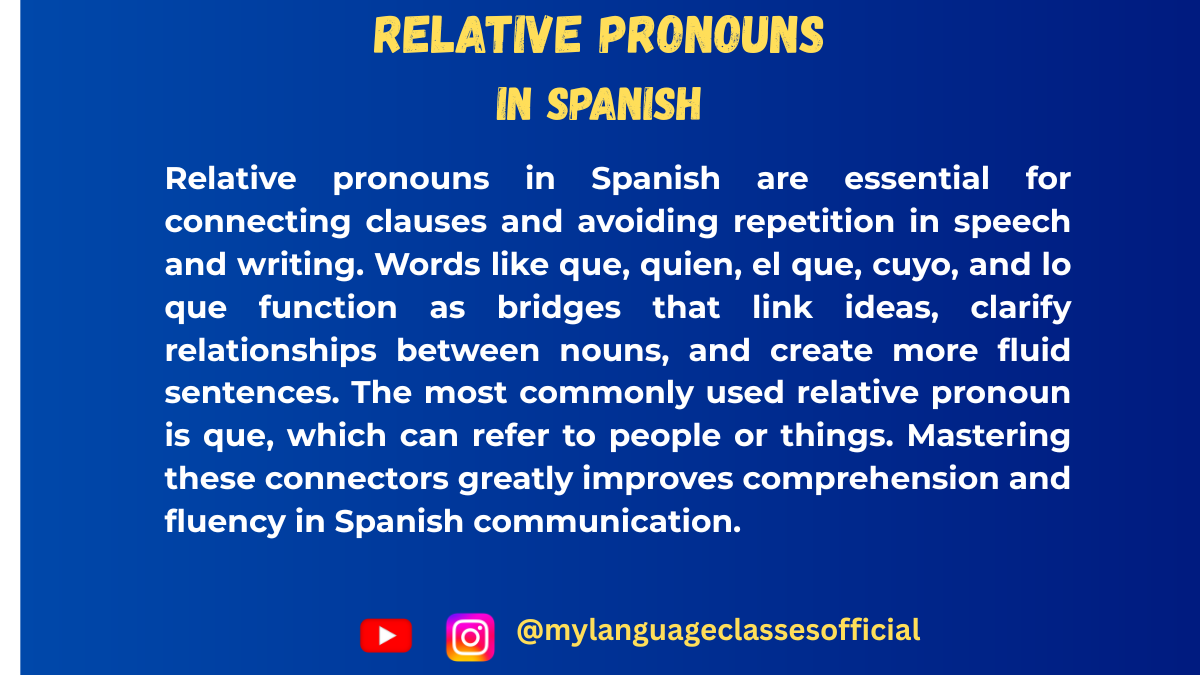
Relative Pronouns in Spanish: Que, Quien, Donde, and Others
When learning Spanish, relative pronouns are essential for connecting sentences smoothly and making speech more fluid. These pronouns allow us to refer to people, places, or things without unnecessary repetition. In this blog post, we will explore the different relative pronouns in Spanish, their meanings, and how to use them correctly.
List of Relative Pronouns in Spanish
Relative pronouns in Spanish are used to introduce subordinate clauses and refer to a previously mentioned noun (antecedent). Below is a list of the most common relative pronouns, their meanings, and example sentences:
Relative Pronoun Meaning Example Sentence 1 Example Sentence 2 Que That, which, who La casa que compré es muy grande. La película que vimos fue interesante. Quien / Quienes Who, whom Mi amiga, quien vive en Madrid, me visitó ayer. Los estudiantes, quienes aprobaron, celebraron. Cuyo / Cuya / Cuyos / Cuyas Whose El hombre cuyo coche es rojo está aquí. La chica cuya madre es doctora es mi amiga. Donde Where La ciudad donde nací es hermosa. Este es el restaurante donde cenamos anoche. El que / La que / Los que / Las que The one(s) who/that El libro, el que compraste, es interesante. Las chicas, las que llegaron tarde, son mis amigas. El cual / La cual / Los cuales / Las cuales The one(s) who/that (formal) La casa en la cual crecí está en ruinas. Los estudiantes, los cuales fueron premiados, estaban felices. Lo que What, which No entiendo lo que dijiste. Lo que más me gusta es viajar. Lo cual Which (referring to a whole idea) Perdimos el tren, lo cual fue un problema. Llegó tarde, lo cual nos molestó mucho. Cuanto / Cuanta / Cuantos / Cuantas As much/many as Toma cuanto quieras. Cuantas veces lo intentó, falló. More Example Sentences
- La mujer que trabaja en la tienda es muy amable.
- Mi amigo, quien es muy inteligente, siempre me ayuda.
- El perro cuyo dueño es mi vecino es muy juguetón.
- No entiendo lo que está pasando.
- El país donde nací es hermoso.
- Los estudiantes, los cuales estudian mucho, sacaron buenas notas.
- La casa en la que crecí tiene muchos recuerdos.
- No sé lo que quieres decir.
- Las flores que compraste son muy bonitas.
- La ciudad donde vivo tiene muchas atracciones turísticas.
Things to Keep in Mind
- Agreement in Gender and Number:
- “Cuyo” agrees in gender and number with the noun it modifies: El hombre cuyos hijos estudian aquí…
- “El que, la que, los que, las que” also change according to the noun they refer to.
- Use of Articles:
- “El cual, la cual, los cuales, las cuales” often appear with a preposition and are more formal.
- “Lo que” and “lo cual” refer to entire ideas or situations.
- Que vs. Quien:
- “Que” is used for both people and objects.
- “Quien” is used mainly for people and must match singular or plural (quien/quienes).
- Where to Use Relative Pronouns:
- “Donde” is for places.
- “Lo que” and “lo cual” refer to abstract concepts.
- “Cuyo” means “whose” and agrees with the possessed noun.
Fill in the Blanks
- La chica _______ vive al lado es muy simpática.
- El perro _______ dueño es mi vecino ladra mucho.
- No entiendo _______ dices.
- La ciudad _______ naciste es hermosa.
- Mi amigo, _______ es doctor, trabaja en el hospital.
- Las flores, _______ compraste ayer, están muy bonitas.
- Juan, _______ hermano es mi compañero, me ayudó con la tarea.
- La razón por _______ llegamos tarde fue el tráfico.
- No sabía _______ querías decir.
- El edificio _______ ventanas son grandes es nuevo.
Answers
- que
- cuyo
- lo que
- donde
- quien
- las que
- cuyo
- la cual
- lo que
- cuyas
Conclusion
Mastering relative pronouns in Spanish is essential for improving fluency and making speech more natural. Understanding the gender, number agreement, and context in which each pronoun is used will help you construct sentences more accurately. Keep practicing with different sentence structures, and soon, using these pronouns will become second nature.
If you enjoyed this lesson, be sure to check out more posts like this on my blog at My Language Classes. Don’t forget to subscribe my YouTube channel and follow me on Instagram for the latest language learning tips and lessons. Leave a comment below to share your thoughts, or ask any questions you have.
Happy learning! 😊
-
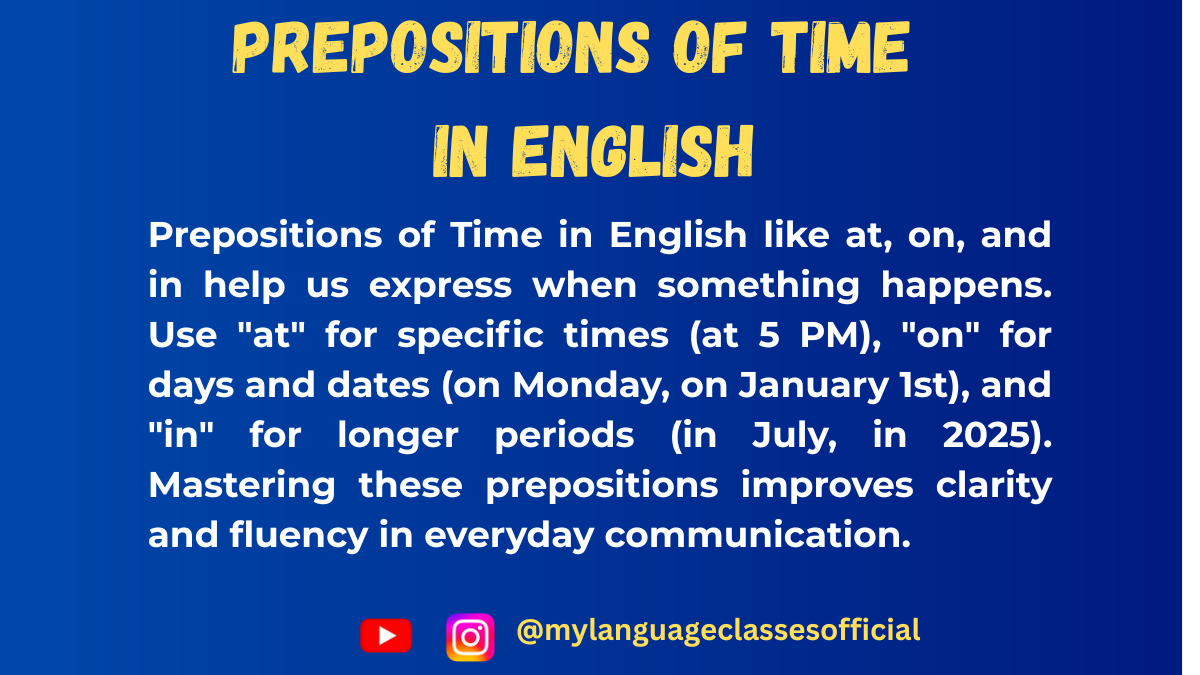
Prepositions of Time in English
Prepositions of time are essential in English grammar as they help us understand when an event occurs. They connect nouns or pronouns with time-related elements, clarifying specific moments, durations, or general time frames. In this blog, we will explore the different prepositions of time, their usages, examples, and important points to remember.
List of Prepositions of Time and Their Usage
Below is a list of common prepositions of time along with their specific usage and example sentences.
Preposition Usage Example Sentence 1 Example Sentence 2 At Specific time of the day, festivals, and specific points in time I wake up at 6 AM. We will meet at Christmas. On Specific days and dates I was born on Monday. The party is on 5th June. In Months, years, centuries, long periods I was born in December. We will visit Japan in 2025. By A deadline or before a certain time You must submit the report by Monday. She will be home by 7 PM. Before An event occurring earlier than a certain time Finish your work before sunset. He arrived before me. After An event occurring later than a certain time We will go out after lunch. She arrived after the meeting started. Since A point in time until now She has been here since morning. I have lived here since 2010. For Duration of time She stayed here for two weeks. I have known him for ten years. During Within a specific period He slept during the lecture. We traveled during the holidays. From…to A specific time range The shop is open from 9 AM to 5 PM. The movie runs from 6 PM to 8 PM. Until/till Up to a certain point in time Wait here until I return. The shop is open till midnight. Within Before the end of a specific period The work will be done within an hour. We will reach there within two days.
More Example Sentences
- She will call me at noon.
- The meeting is scheduled on Tuesday.
- We moved to this city in 2018.
- Complete your assignment by tomorrow.
- The baby slept before dinner.
- We will go out after the rain stops.
- She has lived here since 2015.
- He was on vacation for a month.
- The crowd cheered during the match.
- The library is open from 9 AM to 7 PM.
Things to Keep in Mind
- At is used for specific points in time, while on is for specific days and dates.
- In is used for months, years, centuries, and longer periods.
- Since refers to a specific point in time, while for is used for a duration.
- By means “no later than,” whereas before means “earlier than.”
- Until/till is used when something continues up to a point in time.
- From…to marks the beginning and end of a time period.
- During is used to indicate something happening within a specific period.
- Within suggests a task or event will occur before a given period ends.
Fill in the Blanks
- The train will arrive ___ 6 PM.
- She was born ___ March.
- We will go on a trip ___ summer vacation.
- He stayed in London ___ two years.
- You should submit the form ___ Monday.
- The lights went out ___ the movie.
- I have been waiting here ___ morning.
- We will complete the project ___ two weeks.
- They will be back home ___ midnight.
- The concert will be held ___ Friday night.
Answers
- at
- in
- during
- for
- by
- during
- since
- within
- at
- on
Conclusion
Understanding and correctly using prepositions of time is crucial for clear and precise communication. These prepositions help in framing accurate sentences, making conversations and writing more effective. By practicing their usage and remembering their specific contexts, you can enhance your command over the English language. Keep practicing, and soon, using prepositions of time will become second nature!
If you enjoyed this lesson, be sure to check out more posts like this on my blog at My Language Classes. Don’t forget to subscribe my YouTube channel and follow me on Instagram for the latest language learning tips and lessons. Leave a comment below to share your thoughts, or ask any questions you have about nouns.
Happy learning! 😊
-
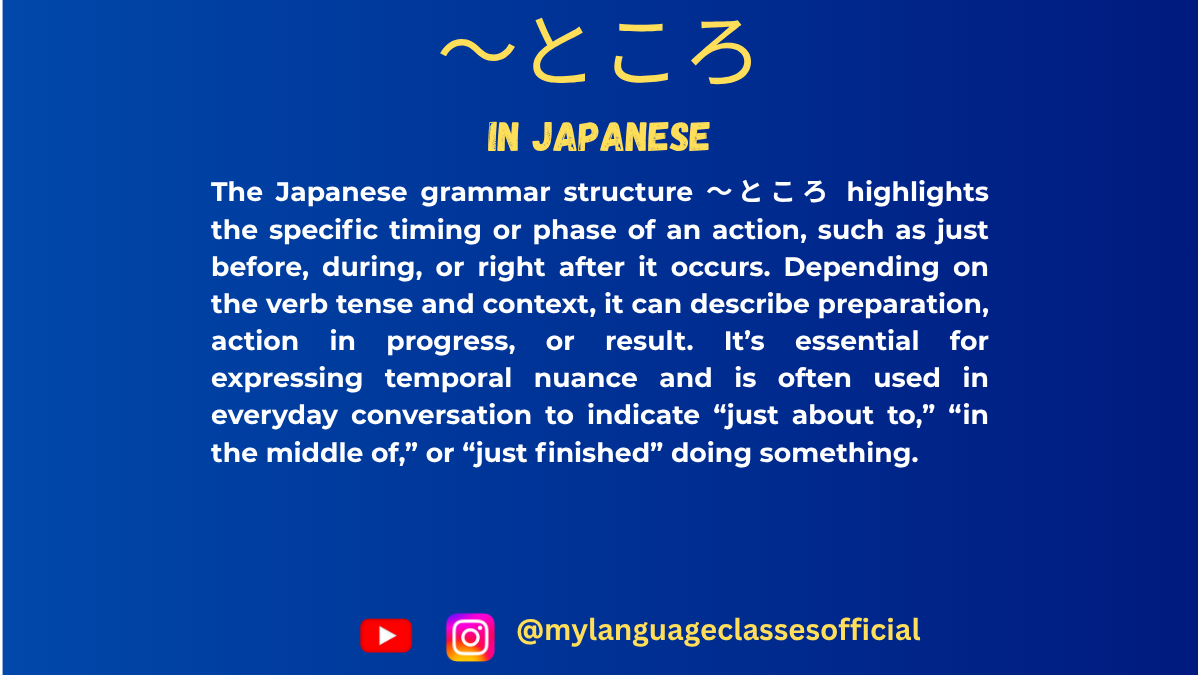
How to Use 〜ところ in Japanese | My Language Classes
Using 〜ところ Form in Japanese
The 〜ところ form is a crucial grammatical structure in Japanese that expresses different stages of an action. It helps indicate whether an action is about to happen, is in progress, or has just been completed. This blog post will cover the formation of 〜ところ for all three verb groups, its various uses, and provide example sentences, things to keep in mind, exercises, and a conclusion.
Formation of 〜ところ Form
Group 1 (Ichidan Verbs)
For ichidan (一段) verbs, remove る from the dictionary form and add the appropriate auxiliary:
- Before the action: 〜るところ
- During the action: 〜ているところ
- After the action: 〜たところ
Example:
- 食べる (taberu – to eat)
- Before: 食べるところ (taberu tokoro)
- During: 食べているところ (tabete iru tokoro)
- After: 食べたところ (tabeta tokoro)
Group 2 (Godan Verbs)
For godan (五段) verbs, use the same rules as ichidan verbs but conjugate accordingly:
- Before the action: Dictionary form + ところ
- During the action: て-form + いるところ
- After the action: た-form + ところ
Example:
- 読む (yomu – to read)
- Before: 読むところ (yomu tokoro)
- During: 読んでいるところ (yonde iru tokoro)
- After: 読んだところ (yonda tokoro)
Group 3 (Irregular Verbs)
For irregular verbs like する and くる:
- する (suru – to do)
- Before: するところ (suru tokoro)
- During: しているところ (shite iru tokoro)
- After: したところ (shita tokoro)
- くる (kuru – to come)
- Before: くるところ (kuru tokoro)
- During: きているところ (kite iru tokoro)
- After: きたところ (kita tokoro)
Usage of 〜ところ
Situations where 〜ところ is used:
Situation Form Used Example Right before an action るところ 今から寝るところです。 (I’m just about to sleep.) In the middle of an action ているところ ちょうど宿題をしているところです。 (I am in the middle of doing my homework.) Just after an action たところ ちょうどご飯を食べたところです。 (I just finished eating.) To indicate an important moment る・ている・たところ 試験を受けるところだった。(I was just about to take the exam.) When explaining a sequence of events たところ 先生に聞いたところ、すぐに答えがわかった。(When I asked the teacher, I immediately understood the answer.)
Example Sentences
- 電車が出発するところです。
Densha ga shuppatsu suru tokoro desu.
(The train is about to depart.) - 彼は今、電話しているところです。
Kare wa ima, denwa shite iru tokoro desu.
(He is on the phone right now.) - ちょうど昼ご飯を食べたところです。
Choudo hirugohan o tabeta tokoro desu.
(I just finished eating lunch.) - 飛行機が今にも飛ぶところです。
Hikouki ga ima ni mo tobu tokoro desu.
(The airplane is just about to take off.) - 友達と話しているところでした。
Tomodachi to hanashite iru tokoro deshita.
(I was in the middle of talking with my friend.) - 彼に聞いたところ、すぐに答えてくれました。
Kare ni kiita tokoro, sugu ni kotaete kuremashita.
(When I asked him, he answered immediately.) - ちょうど今、家を出るところです。
Choudo ima, ie o deru tokoro desu.
(I am just about to leave home.) - 映画を見ているところです。
Eiga o mite iru tokoro desu.
(I am in the middle of watching a movie.) - 買い物が終わったところです。
Kaimono ga owatta tokoro desu.
(I just finished shopping.) - 勉強するところだったのに、友達が来ました。
Benkyou suru tokoro datta noni, tomodachi ga kimashita.
(I was about to study, but my friend came.)
Things to Keep in Mind
- 〜ところ emphasizes timing rather than the state of an action.
- Be careful not to confuse たところ with たばかり; たところ emphasizes immediate completion.
- ているところ is often used to explain ongoing actions.
- This form is frequently used with words like ちょうど (exactly, just), 今 (now), まさに (precisely).
Fill in the Blanks
- ちょうど今、映画を____ところです。
- 飛行機が____ところでした。
- 彼は電話を____ところです。
- 今、家を____ところです。
- 私は宿題を____ところだった。
- 友達が来たので、ちょうど出かける____だった。
- 先生に聞いた____、すぐに理解しました。
- 彼はまだ寝る____ではありません。
- ちょうどレポートを____ところでした。
- 仕事が終わった____です。
Answers
- 見ている
- 飛ぶ
- している
- 出る
- する
- ところ
- ところ
- ところ
- 書く
- ところ
Conclusion
The 〜ところ form is an essential grammar point that helps clarify the timing of an action. Whether something is about to happen, currently happening, or has just happened, understanding how to use 〜ところ correctly will significantly improve your Japanese fluency. Keep practicing, and soon this structure will become second nature in your conversations!
If you enjoyed this lesson, be sure to check out more posts like this on my blog at My Language Classes. Don’t forget to subscribe my YouTube channel and follow me on Instagram for the latest language learning tips and lessons. Leave a comment below to share your thoughts, or ask any questions you have about nouns.
Happy learning! 😊
-

Use of Infinitive After Prepositions in Spanish
In Spanish, when a verb follows a preposition, it must always be in its infinitive form. Unlike English, where the gerund (-ing form) is often used after prepositions, Spanish strictly requires the infinitive. Understanding this grammatical rule is essential for forming correct sentences and sounding natural in Spanish.
This blog post will cover the different situations in which the infinitive is used after prepositions, common expressions with their meanings and examples, and essential points to keep in mind while using them.
Situations Where the Infinitive is Used After Prepositions
- Purpose or Goal (para + infinitive)
- Used to indicate the purpose or objective of an action.
- Example: Estudio para aprender. (I study to learn.)
- Means or Manner (con + infinitive)
- Expresses the way in which something is done.
- Example: Mejorarás con practicar. (You will improve by practicing.)
- Cause or Reason (por + infinitive)
- Indicates the reason for an action.
- Example: Me castigaron por llegar tarde. (They punished me for arriving late.)
- Condition (de + infinitive)
- Expresses conditions in certain phrases.
- Example: De saberlo, te lo habría dicho. (Had I known, I would have told you.)
- After Prepositions of Time (antes de/después de + infinitive)
- Used when referring to actions occurring before or after another action.
- Example: Voy a ducharme después de correr. (I am going to shower after running.)
- Prepositions Indicating a Point of Reference (sin, hasta, en, etc.)
- Used in fixed expressions and idiomatic phrases.
- Example: No puedes salir sin avisar. (You can’t leave without letting us know.)
Common Expressions with Infinitives After Prepositions
Expression Meaning Example 1 Example 2 Para estudiar To study Voy a la biblioteca para estudiar. Uso aplicaciones para estudiar español. Por llegar tarde For arriving late Me regañaron por llegar tarde. Perdí el tren por salir tarde. Con practicar By practicing Mejoras con practicar cada día. Con practicar, hablas mejor. Antes de dormir Before sleeping Leo antes de dormir. Me lavo la cara antes de dormir. Después de comer After eating Me cepillo los dientes después de comer. Llamó después de almorzar. Sin avisar Without warning No puedes irte sin avisar. Entró sin avisar. Hasta terminar Until finishing No salgo hasta terminar la tarea. No puedo descansar hasta terminar. De saberlo Had I known De saberlo, no lo habría hecho. De saberlo antes, te habría avisado. En aprender In learning Invierto tiempo en aprender español. Me esfuerzo en aprender bien. A pesar de fallar Despite failing Sigo intentándolo a pesar de fallar. Aprobó a pesar de fallar el primer intento.
More Example Sentences
- Fui al mercado para comprar frutas.
- No puedes entrar sin pagar la entrada.
- Me llamó después de haber terminado el trabajo.
- Logró su meta con dedicarse al estudio.
- Antes de salir, revisa tu mochila.
- Me fui temprano por evitar el tráfico.
- No puedes dormir sin apagar la luz.
- No podré jugar hasta mejorar mi salud.
- De haber sabido la verdad, habría reaccionado diferente.
- A pesar de tener miedo, enfrentó la situación.
Fill in the Blanks
- Voy al gimnasio ________ estar en forma. (para)
- Me castigaron ________ decir una mentira. (por)
- No puedes viajar ________ tu pasaporte. (sin)
- Voy a descansar ________ trabajar todo el día. (después de)
- No saldré ________ terminar el proyecto. (hasta)
- Aprendí español ________ estudiar mucho. (con)
- De ________ que vendrías, habría preparado algo especial. (saber)
- Siempre leo un libro ________ dormir. (antes de)
- Se esforzó mucho ________ ganar el premio. (para)
- Consiguió su objetivo ________ muchos intentos fallidos. (a pesar de)
Answers
- para
- por
- sin
- después de
- hasta
- con
- saber
- antes de
- para
- a pesar de
Things to Keep in Mind
- The verb after the preposition always remains in its infinitive form.
- Prepositions like para, por, sin, antes de, and después de commonly appear before infinitives.
- In cases where an article (el, la, los, las) is used, ensure agreement in gender and number.
- Some phrases change meaning slightly depending on the preposition used (e.g., por estudiar vs. para estudiar).
Conclusion
Using the infinitive after prepositions is a fundamental rule in Spanish. Unlike English, which often uses gerunds, Spanish requires the verb to stay in its base form. Mastering this concept will improve fluency and accuracy in constructing sentences. Practice with the expressions provided, and soon, this rule will become second nature in your Spanish conversations!
If you enjoyed this lesson, be sure to check out more posts like this on my blog at My Language Classes. Don’t forget to subscribe my YouTube channel and follow me on Instagram for the latest language learning tips and lessons. Leave a comment below to share your thoughts, or ask any questions you have.
Happy learning! 😊
- Purpose or Goal (para + infinitive)
-

Prepositions of Place in English
Prepositions of place are essential in English as they help indicate the location of people, objects, or actions. Understanding them correctly enhances fluency and accuracy in spoken and written English. This article will provide a detailed explanation, a categorized list, examples, exercises, and essential things to remember while using prepositions of place.
What is a Preposition of Place?
A preposition of place is a word used to show the location or position of an object concerning another object. These prepositions answer the question “Where?” and are essential for clear communication.
List of Prepositions of Place and Their Usage
Below is a list of commonly used prepositions of place along with their meanings and example sentences.
Preposition Usage Example 1 Example 2 In Inside a space, area, or container The books are in the bag. She is in the room. On On the surface of something The book is on the table. There is a painting on the wall. At A specific point or location She is at the bus stop. We met at the restaurant. Under Below something The cat is under the table. He hid under the bed. Over Above something without touching The lamp is over the table. The bridge is over the river. Above Higher than something The clock is above the door. Planes fly above the clouds. Below Lower than something His shoes are below the bed. The valley is below the mountain. Between In the middle of two things The park is between the school and the mall. She sat between her friends. Next to Beside something The school is next to the hospital. She is sitting next to her brother. Behind At the back of something The car is behind the building. There is a garden behind the house. In front of Before something The teacher is in front of the class. There is a park in front of my house. Inside Within an enclosed space The keys are inside the drawer. She stayed inside the house. Outside Opposite of inside The kids are playing outside the house. There is a cat outside the shop. Near Close to something There is a bank near my house. She lives near the station. Far from Distant from something His school is far from his home. The hotel is far from the airport.
More Example Sentences:
- There is a mirror on the wall.
- The plane is flying above the clouds.
- She is waiting at the entrance.
- The ball is under the chair.
- The bakery is next to the supermarket.
- He kept his phone inside his pocket.
- The children are playing outside the house.
- The library is between the coffee shop and the bank.
- The painting is hanging over the sofa.
- There is a tree behind the house.
Fill in the Blanks:
- The cat is ___ the table.
- The park is ___ the school and the library.
- She is waiting ___ the bus stop.
- The ball rolled ___ the couch.
- The students are sitting ___ the teacher.
- The books are ___ the bag.
- The hotel is ___ the beach.
- The keys are ___ the drawer.
- He is standing ___ the door.
- The stars are shining ___ the sky.
Answers:
- under
- between
- at
- under
- in front of
- in
- near
- inside
- behind
- above
Things to Keep in Mind:
- Articles: Use definite and indefinite articles appropriately (e.g., “in a house” vs. “in the house”).
- Gender & Number: Prepositions of place do not change based on gender but may be influenced by singular/plural usage (e.g., “between two buildings”).
- Fixed Expressions: Some prepositions are part of set phrases, such as “at home,” “on the street,” or “in bed.”
- Context Matters: Some prepositions can change meaning based on the context (e.g., “on the bus” vs. “in the car”).
- Prepositions vs. Adverbs: Some words can function as both prepositions and adverbs. For example, “inside” can be a preposition in “inside the house” but an adverb in “Come inside!”
Conclusion
Prepositions of place are fundamental in English grammar and crucial for describing locations accurately. By understanding their usage and practicing them through exercises, you can significantly improve your English fluency. Keep practicing with real-life situations, and soon, using prepositions of place will become second nature!
If you enjoyed this lesson, be sure to check out more posts like this on my blog at My Language Classes. Don’t forget to subscribe my YouTube channel and follow me on Instagram for the latest language learning tips and lessons. Leave a comment below to share your thoughts, or ask any questions you have about nouns.
Happy learning! 😊
-
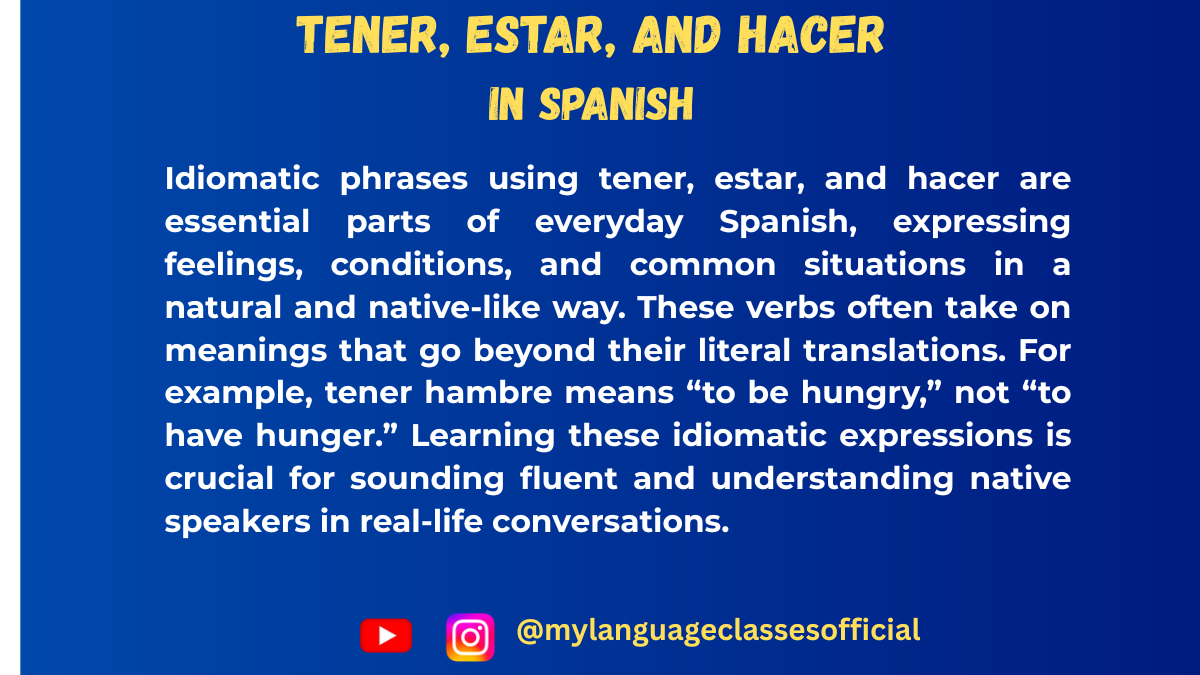
Idiomatic Phrases Using Tener, Estar, and Hacer in Spanish
Mastering idiomatic expressions is essential for achieving fluency in Spanish. Many common expressions in Spanish use the verbs tener (to have), estar (to be), and hacer (to do/make), which often don’t translate literally into English. In this blog, we will explore frequently used phrases such as tener razón, tener ganas de, estar de acuerdo, and many others, along with their meanings, uses, and examples.
Understanding Tener, Estar, and Hacer in Idiomatic Expressions
In Spanish, some expressions that involve states, desires, or idiomatic ideas use tener, estar, or hacer, instead of ser or other verbs we might expect in English.
- Tener is often used for conditions, feelings, or necessity.
- Estar is used for temporary states, emotions, and agreements.
- Hacer is commonly used for weather expressions and actions.
To form these idiomatic phrases, we follow these patterns:
✅ Tener + noun → (e.g., tener razón – “to be right”)
✅ Estar + prepositional phrase/adjective → (e.g., estar de acuerdo – “to agree”)
✅ Hacer + noun → (e.g., hacer frío – “to be cold (weather-wise)”)
Common Expressions Using Tener, Estar, and Hacer
Here is a list of beginner and intermediate-level expressions along with their meanings and example sentences.
Expression Meaning Example 1 Example 2 Tener hambre To be hungry Tengo hambre, ¿puedo comer algo? (I am hungry, can I eat something?) Los niños tienen hambre después de jugar. (The children are hungry after playing.) Tener sed To be thirsty Después de correr, siempre tengo mucha sed. (After running, I am always very thirsty.) ¿Tienes sed? Hay agua en la nevera. (Are you thirsty? There is water in the fridge.) Tener razón To be right Tienes razón, era una mala idea. (You are right, it was a bad idea.) El profesor tenía razón sobre la respuesta. (The teacher was right about the answer.) Tener ganas de + infinitive To feel like (doing something) Tengo ganas de viajar a España. (I feel like traveling to Spain.) No tengo ganas de salir hoy. (I don’t feel like going out today.) Tener cuidado To be careful ¡Ten cuidado con el perro! (Be careful with the dog!) Debes tener cuidado al cruzar la calle. (You must be careful when crossing the street.) Tener sueño To be sleepy Después de estudiar, tengo mucho sueño. (After studying, I am very sleepy.) Ella siempre tiene sueño por la mañana. (She is always sleepy in the morning.) Estar de acuerdo To agree Estoy de acuerdo contigo. (I agree with you.) Mis padres no están de acuerdo con mi decisión. (My parents do not agree with my decision.) Estar de buen/mal humor To be in a good/bad mood Hoy estoy de buen humor. (Today I am in a good mood.) Después del examen, estaba de mal humor. (After the exam, I was in a bad mood.) Hacer frío/calor To be cold/hot (weather) Hace mucho frío en invierno. (It is very cold in winter.) En la playa, hace calor. (At the beach, it is hot.) Hacer falta To be necessary/to need Hace falta estudiar para el examen. (It is necessary to study for the exam.) Nos hace falta más información. (We need more information.)
More Example Sentences
- Hace mucho viento hoy. (It is very windy today.)
- Tienes razón, esto no es fácil. (You are right, this is not easy.)
- No estoy de acuerdo con esa idea. (I do not agree with that idea.)
- Hace falta paciencia para aprender un idioma. (Patience is necessary to learn a language.)
- Ten cuidado, la carretera está resbaladiza. (Be careful, the road is slippery.)
- Siempre tengo ganas de comer pizza los viernes. (I always feel like eating pizza on Fridays.)
- Mi hermana tiene sueño porque estudió hasta tarde. (My sister is sleepy because she studied late.)
- En verano hace mucho calor en mi ciudad. (In summer, it is very hot in my city.)
- Después del trabajo, mi madre siempre está de buen humor. (After work, my mom is always in a good mood.)
- Los estudiantes no están de acuerdo con las nuevas reglas. (The students do not agree with the new rules.)
Fill in the Blanks
- ______ cuidado cuando cruzas la calle.
- Después de correr, ______ sed.
- ¿Tú ______ de acuerdo con esa decisión?
- Esta sopa está caliente, ______ falta más agua fría.
- En invierno ______ frío, así que uso un abrigo.
- Hoy no ______ ganas de salir.
- Mi hermana siempre ______ sueño por la mañana.
- Tú siempre ______ razón en las discusiones.
- Mis amigos y yo ______ de buen humor porque es viernes.
- ¡______ falta estudiar más para el examen!
Answers:
- Ten
- Tengo
- Estás
- Hace
- Hace
- Tengo
- Tiene
- Tienes
- Estamos
- Hace
Things to Keep in Mind
- Tener expressions use a noun, meaning they follow gender and number rules. Example: Tener hambre (hunger, feminine noun) vs. Tener ganas de (desires, plural noun).
- Estar expressions often use prepositional phrases such as de acuerdo or de buen humor.
- Hacer expressions are commonly used for weather, e.g., Hace frío instead of Es frío.
- Some phrases change based on the subject. Example: Tengo ganas de comer (I feel like eating) vs. Tenemos ganas de viajar (We feel like traveling).
Conclusion
Using idiomatic expressions with tener, estar, and hacer correctly will make your Spanish sound more natural and fluent. These phrases often don’t translate directly into English, so understanding their structure and use in different contexts is essential. Keep practicing these expressions in daily conversations to improve your fluency and confidence in Spanish!
If you enjoyed this lesson, be sure to check out more posts like this on my blog at My Language Classes. Don’t forget to subscribe my YouTube channel and follow me on Instagram for the latest language learning tips and lessons. Leave a comment below to share your thoughts, or ask any questions you have.
Happy learning! 😊

